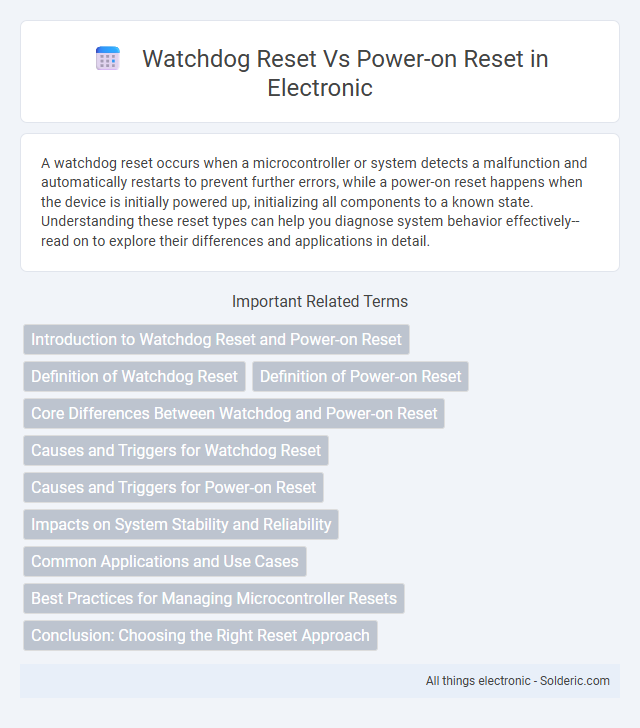A watchdog reset occurs when a microcontroller or system detects a malfunction and automatically restarts to prevent further errors, while a power-on reset happens when the device is initially powered up, initializing all components to a known state. Understanding these reset types can help you diagnose system behavior effectively--read on to explore their differences and applications in detail.
Comparison Table
| Feature | Watchdog Reset | Power-on Reset (POR) |
|---|---|---|
| Trigger Condition | System hang or software failure detected by watchdog timer | Initial power application or power cycle |
| Purpose | Recover system from software faults | Ensure correct start-up initialization |
| Reset Source | Internal watchdog timer | Power supply circuitry |
| When It Occurs | During runtime if system fails to respond | At system power-up or after power loss |
| Effect on System State | Resets processor, may preserve some power states | Full system reset, clears all states |
| Common Use | Fault tolerance and reliability improvement | Initial system boot and hardware reset |
Introduction to Watchdog Reset and Power-on Reset
Watchdog reset and power-on reset are crucial mechanisms in embedded systems to ensure reliable operation. A watchdog reset occurs when the system's watchdog timer detects a failure or software hang, triggering an automatic reset to recover normal function. Power-on reset, on the other hand, happens when the system is powered on or after a complete loss of power, initializing the device to a known state before starting operation.
Definition of Watchdog Reset
A Watchdog Reset occurs when a microcontroller's watchdog timer detects system malfunction or software hang, triggering an automatic restart to restore normal operation. This reset is crucial for maintaining system reliability by preventing indefinite freezes that occur without user intervention. Your device relies on the watchdog reset mechanism to recover from unexpected faults, unlike a Power-on Reset which happens only during initial power application.
Definition of Power-on Reset
Power-on reset is a hardware mechanism that initializes a microcontroller or processor to a known state whenever the device is powered on or experiences a voltage drop below a certain threshold. This reset ensures that your system starts reliably by clearing registers and resetting configuration settings to their default values. Watchdog reset, in contrast, occurs when the watchdog timer detects a system malfunction or software hang, triggering a system reset to recover from operational faults.
Core Differences Between Watchdog and Power-on Reset
Watchdog reset triggers when the system software fails to operate correctly, automatically restarting the processor to recover from software faults. Power-on reset occurs during initial power application, initializing hardware states and ensuring a clean system start. You can rely on watchdog resets to maintain system stability during runtime, while power-on resets establish the baseline state at device startup.
Causes and Triggers for Watchdog Reset
Watchdog reset occurs when a system's watchdog timer detects a software malfunction or unresponsive state, triggering a reset to recover normal operation. Causes for watchdog reset include infinite loops, deadlocks, or failure to service the watchdog within a specified timeout period. This contrasts with power-on reset, which is initiated by the initial powering up of a device or a sudden loss and restoration of power supply.
Causes and Triggers for Power-on Reset
Power-on reset occurs when your device powers up from a fully off state, triggered by the initial application of power that forces all registers and circuits to their default states. Unlike watchdog reset--which activates due to software faults or clock issues--a power-on reset is caused primarily by voltage fluctuations, cold starts, or hardware resets triggered by physical power cycle events. The reliability of your system during startup depends heavily on managing these power-on reset triggers to ensure stable initialization.
Impacts on System Stability and Reliability
Watchdog resets enhance system stability by recovering the device from software faults or unresponsive states without a complete power cycle, preserving ongoing processes and data integrity. Power-on resets, triggered by a full system reboot, ensure hardware initialization and a clean system start but can interrupt operations and increase downtime. Your choice between these resets affects reliability by balancing quick recovery with system state preservation.
Common Applications and Use Cases
Watchdog reset is commonly used in embedded systems and microcontrollers to automatically recover from software malfunctions and system hangs, ensuring continuous operation. Power-on reset occurs when a device is powered up or restarted, initializing hardware and setting system registers to default states, which is essential in starting device boot sequences. Watchdog reset is often applied in industrial automation, automotive systems, and IoT devices, whereas power-on reset is foundational in virtually all electronic devices to guarantee reliable startup.
Best Practices for Managing Microcontroller Resets
Watchdog reset and power-on reset serve distinct purposes in microcontroller reliability, with the watchdog reset recovering the system from software faults by automatically triggering after a timeout, while the power-on reset ensures a clean start by initializing hardware states during power-up. Best practices involve configuring the watchdog timer with appropriate timeout intervals to balance fault detection without false triggers and ensuring power-on resets properly initialize all critical peripherals and registers. You should implement both mechanisms strategically to maintain system stability and facilitate reliable recovery from faults or unexpected power cycles.
Conclusion: Choosing the Right Reset Approach
Watchdog reset provides a quick recovery mechanism by automatically resetting the system during software failures, ensuring minimal downtime and maintaining operational continuity. Power-on reset initializes hardware components and clears system states during startup, offering a reliable way to start from a known, stable condition. Selecting the appropriate reset approach depends on system requirements for recovery speed, fault tolerance, and hardware state initialization to optimize overall system reliability and performance.
Watchdog reset vs Power-on reset Infographic

 solderic.com
solderic.com